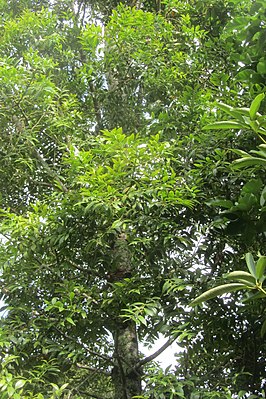Agathis kinabaluensis
| Agathis kinabaluensis | ||||||||||||
|---|---|---|---|---|---|---|---|---|---|---|---|---|

Agathis kinabaluensis |
||||||||||||
| Systematics | ||||||||||||
|
||||||||||||
| Scientific name | ||||||||||||
| Agathis kinabaluensis | ||||||||||||
| De foliage. |
Agathis kinabaluensis is a species ofthe Araucaria family (Araucariaceae). It is endemic to Mount Kinabalu and possibly Mount Murud on the island of Borneo .
description
Agathis kinabaluensis grows as an evergreen tree that can reach heights of up to 36 meters. The trunk bark, which has numerous lenticels , is dark brown and the inner bark is reddish in color. Young trees have a smooth bark that becomes grainy with age and flakes off in irregularly shaped plates. The resin is white.
Young leaves stand on a short petiole and are round in shape with a length of up to 9 centimeters and a width of around 4.4 centimeters. They have a pointed tip of the leaf. Older leaves are also on a short petiole and are also rounded with a length of 4 to 7 centimeters and a width of 1.8 to 3.2 centimeters. They have a pointed or blunt tip of the leaf. The underside of the leaf is not colored blue-green.
The male cones stand on a stalk about 0.4 centimeters long and are cylindrical in shape with a length of 2 to 3 centimeters and a thickness of around 0.9 centimeters. The female cones are up to 11 inches long and about 8 inches thick. They consist of triangular shaped cone scales. The seeds have a pointed protrusion about 2 millimeters long, which faces the two wings.
Distribution and location
The natural range of Agathis kinabaluensis is in Malaysia . There it occurs only on Mount Kinabalu in the province of Sabah in Borneo . A second possible occurrence on Mount Murud in Sarawak Province was identified in 1988 by David John de Laubenfels in the Flora Malesiana as a population of Agathis orbicula .
Agathis kinabaluensis thrives at altitudes of 1500 to 2400 meters. It grows in higher-lying mountain forests, lower-lying forests with moss vegetation and in sub-alpine bushes, especially on nutrient-poor soils that developed on granite , sandstone or ultramafit .
Agathis kinabaluensis is classified as "critically endangered" in the IUCN Red List . The main endangerment factor is the small population size, together with the limited distribution area. Likewise, if the population on Mount Murud is assigned to the species, there is no genetic exchange between the two populations due to the separate geographic location. The total stock is considered to be in decline.
Systematics
Agathis kinabaluensis is assigned to the Agathis section within the genus of the Kauri trees ( Agathis ) .
It was first described as Agathis kinabaluensis in 1979 by David John de Laubenfels in Blumea , Volume 25, Number 2, Page 535.
swell
- Christopher J. Earle: Agathis kinabaluensis. In: The Gymnosperm Database. www.conifers.org, November 23, 2012, accessed on February 2, 2014 .
Individual evidence
- ↑ a b c d e Christopher J. Earle: Agathis kinabaluensis. In: The Gymnosperm Database. www.conifers.org, November 23, 2012, accessed on February 2, 2014 .
- ↑ a b c agathis kinabaluensis in the endangered Red List species the IUCN 2013. Posted by: A. Farjon, 2011. Retrieved on February 2, 2014.
- ↑ Agathis kinabaluensis at Tropicos.org. Missouri Botanical Garden, St. Louis, accessed February 2, 2014.
- ↑ Agathis kinabaluensis. In: The Plant List. www.theplantlist.org, accessed on February 2, 2014 .